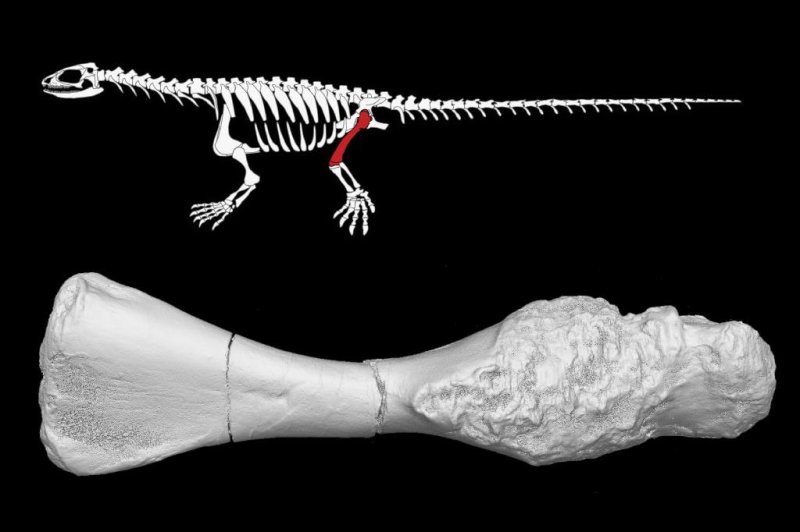1 of 2 | Researchers found the cancerous growth in the femur of an ancient proto-turtle species. Photo by Rainer Schoch/Natural History Museum, Berlin
Feb. 7 (UPI) -- Bone cancer may be nearly as old as bones.
Researchers have discovered evidence of an aggressive malignant tumor in the femur of a 240-million-year-old proto-turtle -- the oldest case of bone cancer in amniotes, a lineage of four-limbed vertebrates that includes birds, reptiles and mammals.
Scientists described their diagnosis this week in the journal JAMA Oncology.
Bone cancer is rare in the fossil record, not because it wasn't around a few hundred million years ago, but because it's hard to spot. Cancerous growths are usually hidden inside bones, only detectable with an X-ray machine or CT scan.
The growth on the femur of Pappochelys rosinae -- perhaps the first turtle species -- can be seen with the naked eye.
While it was obvious there was something wrong with the primitive turtle's thigh bone, scientists weren't sure what the problem was.
"If you looked externally, you could easily think this was an incorrectly healed bone," Yara Haridy, a former medical student and paleontologist at the Natural History Museum in Berlin, told the New York Times. "I thought initially this animal had a broken femoral head or some sort of really bad shin splints."
Researchers used micro-CT scanning to create high-resolution cross-section images of the bone and growth, which was first unearthed in Germany in 2013. It can be difficult for paleontologists to differentiate between cancerous growths and infections, but infections typically feature small sacs previously filled with puss. Images showed the growth was sac-free.
Scientists diagnosed the ancient turtle with periosteal osteosarcoma, a type of bone cancer that affects humans today.
"We are one community which responds to the environment and whatever factors that cause cancer in the same way," Bruce Rothschild, a research associate at the Carnegie Museum of Natural History in Pittsburgh, told Live Science. "We're all part of the same Earth and we are all inflicted with the same phenomena."
As revealed by previously studied fossils, the proto-turtle was wide-bodied and boasted a long tail. And unlike its descendants, the ancient reptile also lacked a shell.
"What makes this really cool is that now we understand that cancer is basically a deeply rooted switch that can be turned on or off," Haridy told the Times. "It's not something that happened recently in our evolution. It's not something that happened early in human history, or even in mammal history."















